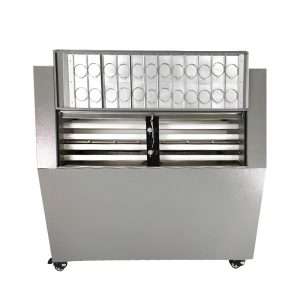Application of UV aging box in automotive interior
The purpose of UV aging tests is to evaluate the weather resistance of automotive interior materials and determine their service life and performance under long-term UV irradiation and climatic conditions. Uv irradiation has the following effects on automotive interior materials:
Fading: UV irradiation can cause the color of automotive interior material surfaces to fade or fade.
Decreased durability: UV irradiation can reduce the durability of automotive interior materials, making them brittle, cracking, or losing elasticity.
Deformation: Long-term UV irradiation can cause deformation of automotive interior materials, such as deformation, warping or distortion of plastic materials.
Application of UV aging box in automotive interior
Reduced wear resistance: UV irradiation can lead to a reduction in the surface hardness of automotive interior materials, thus affecting their wear resistance.

Standard of reference
The industry standards for UV aging test of automotive interior materials mainly include the following:
ISO 4892-2: This standard specifies methods and procedures for UV radiation aging tests of plastic materials under laboratory conditions and is suitable for evaluating the weather resistance of automotive interior materials.
SAE J2412: This is a standard developed by the Society of Automotive Engineers that specifies the methods and requirements for UV irradiation aging testing of automotive interior materials.
Application of UV aging box in automotive interior
Specific application cases
The specific application of UV aging test box in automotive interior is as follows:
Seat materials: For materials such as fabric, leather and faux leather of car seats, UV aging tests can evaluate their color stability and durability.
Instrument panels: Automotive instrument panels are often exposed to sunlight, and UV aging tests can evaluate their resistance to fading, crack and deformation.
Interior panels: For plastic interior panels and trim pieces, UV aging tests can evaluate their color stability, durability, and surface quality changes.
The application of UV aging box in automotive interior is illustrated in Figure 2
Application of UV aging box in automotive interior
Method of test
Using UV aging test chamber to test the aging resistance of automotive interior materials, generally can be carried out according to the following steps:
Prepare samples: according to the characteristics and dimensions of actual automotive interior materials, prepare samples that meet the requirements.
Set test conditions: according to the test requirements or applicable standards, set the UV radiation intensity, temperature, humidity and other test conditions.
Sample placement: Place the sample of automotive interior materials on the sample table in the UV aging test chamber to ensure that the sample is exposed to the light source of UV radiation.
Application of UV aging box in automotive interior
Run test: Allow the sample to be continuously exposed to UV radiation and other test conditions for a certain period of time according to the set test conditions.
Observation and evaluation: Regularly observe and evaluate the changes of samples, including color changes, surface conditions, physical properties changes, etc., and record and record relevant data.
Analysis of results: The aging resistance and expected life of automotive interior materials were evaluated based on the sample changes and performance losses observed during the test.
* Test procedures and parameter Settings should be adjusted and confirmed according to test standards, characteristics of automotive interior materials and actual needs. It is recommended to refer to applicable standards and relevant equipment instructions before performing UV aging tests to ensure the accuracy and reliability of the tests.
